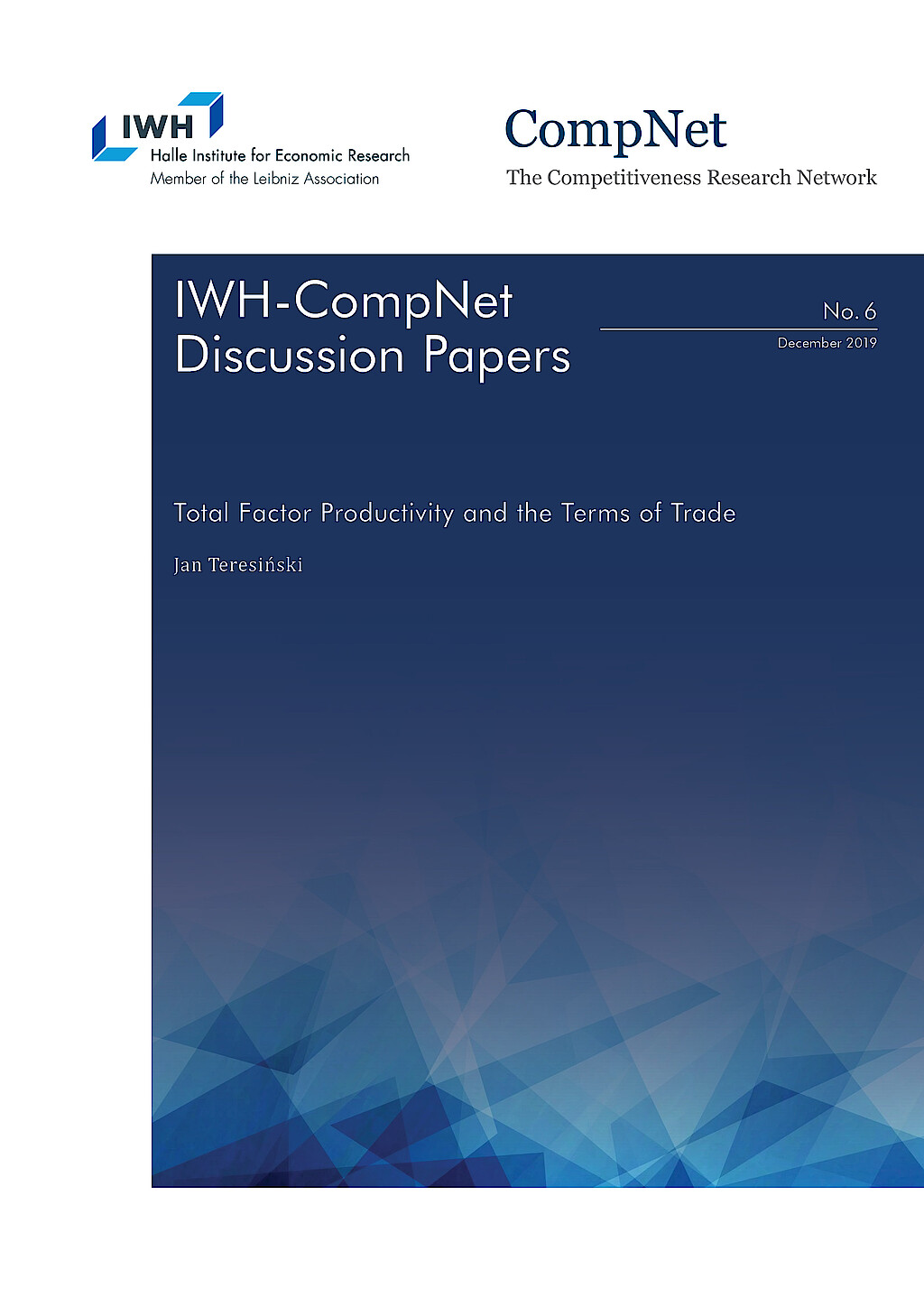IWH-CompNet Discussion Papers
The IWH-CompNet Discussion Paper series presents research based on productivity data provided by the Competitiveness Research Network (CompNet). The international network has the objective to develop a consistent analytical framework for assessing productivity and competitiveness. The papers are released in order to make the research of CompNet generally available, in preliminary form, to encourage comments and suggestions prior to final publication.
Current Issues

Total Factor Productivity and the Terms of Trade
in: IWH-CompNet Discussion Papers, No. 6, 2019
Abstract
In this paper we analyse how the terms of trade (TOT) – the ratio of export prices to import prices – affect total factor productivity (TFP). We provide empirical macroeconomic evidence for the European Union countries based on the times series SVAR analysis and microeconomic evidence based on industry level data from the Competitiveness Research Network (CompNet) database which shows that the terms of trade improvements are associated with a slowdown in the total factor productivity growth. Next, we build a theoretical model which combines open economy framework with the endogenous growth theory. In the model the terms of trade improvements increase demand for labour employed in exportable goods production at the expense of technology production (research and development – R&D) which leads to a shift of resources from knowledge development towards physical exportable goods. This reallocation has a negative impact on the TFP growth. Under a plausible calibration the model is able to replicate the observed empirical pattern.

Employment Protection and Firm-level Job Reallocation:Adjusting for Coverage
in: IWH-CompNet Discussion Papers, No. 5, 2019
Abstract
This paper finds that employment protection legislation (EPL) had a significant impact on employment adjustment in Europe over 2001-2013, once we account for firm-size related exemptions to EPL. We construct a novel coverage-adjusted EPL indicator and find that EPL hinders employment growth at the firm level and increases the share of firms that remain in the same size class. This suggests that stricter EPL restrains job creation because firms fear the costs of shedding jobs during downturns. We do not find evidence that EPL has positive effects on employment by limiting job losses after adverse shocks. In addition to standard controls for the share of credit-constrained firms and the position in the business cycle, we also control for sizerelated corporate tax exemptions and find that these also significantly constrain job creation among incumbent firms.

Price-cost Margin and Bargaining Power in the European Union
in: IWH-CompNet Discussion Papers, No. 4, 2019
Abstract
Using firm-level data between 2004 and 2012 for eleven countries of the European Union (EU), we document the size of product and labour market imperfections within narrowly defined sectors including services which are virtually undocumented. Our findings suggest that perfect competition in both product and labour markets is widely rejected. Levels of the price-cost margin and union bargaining power tend to be higher in some service sectors depicting however substantial heterogeneity. Dispersion within sector and across countries tends to be higher in some services sectors assuming a less tradable nature which suggests that the Single Market integration is partial particularly relaxing the assumption of perfect competition in the labour market. We report also figures for the aggregate economy and show that Eastern countries tend to depict lower product and labour market imperfections compared to other countries in the EU. Also, we provide evidence in favour of a very limited adjustment of both product and labour market imperfections following the international and financial crisis.

The Effect of the Single Currency on Exports: Comparative Firm-level Evidence
in: IWH-CompNet Discussion Papers, No. 1, 2019
Abstract
We investigate how adopting the euro affects exports using firm-level data from Slovakia and Estonia. In contrast to previous studies, we focus on countries that adopted the euro individually and had different exchange rate regimes prior to doing so. Following the New Trade Theory we consider three types of adjustment: firm selection, changes in product varieties and changes in the average value of the exports that compose the exports of individual firms. The euro effect is identified by a difference in differences analysis comparing exports by firms to the euro area countries with exports to the EU countries that are not members of the euro area. The results highlight the importance of the transaction costs channel related to exchange rate volatility. We find the euro has a strong pro-trade effect in Slovakia, which switched to the euro from a floating exchange rate, while it has almost no effect in Estonia, which had a fixed exchange rate to the euro prior to the euro changeover. Our findings indicate that the euro effect manifested itself mainly through the intensive margin and that the gains from trade were heterogeneous across firm characteristics.

Living with Lower Productivity Growth: Impact on Exports
in: IWH-CompNet Discussion Papers, No. 1, 2018
Abstract
This paper investigates the impact of sustained lower productivity growth on exports, by looking at the role of the productivity distribution and allocative efficiency as drivers of export performance. It follows and goes beyond the work of Barba Navaretti et al. (2017), analysing the effects of productivity on exports depending on the dynamics of allocative efficiency. Low productivity growth is a well-documented stylised fact in Western countries – and possibly a reality likely to persist for some time. What could be the impact of persistent sluggish growth of productivity on exports? To shed light on this question, this paper examines the relationship between the productivity distribution of firms and sectoral export performance. The structure of firms within countries or even sectors matters tremendously for the nexus between productivity and exports at the macroeconomic level, as the theoretical and empirical literature documents. For instance, whether too few firms at the top (lack of innovation) or too many firms at the bottom (weak market selection) drives slow average productivity at the macro level has very different implications and therefore demands different policy responses.



